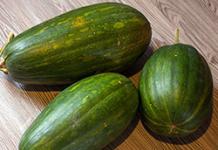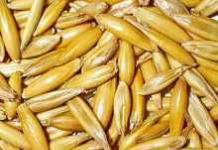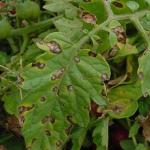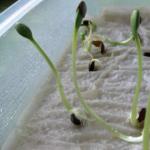Good afternoon, dear friends!
Summer residents who use the principles of organic farming on their plots have long adopted the method of green manure. Planting various crops in areas of the dacha that are temporarily free from main crops, followed by embedding the vegetative mass into the soil is a proven, effective and very inexpensive way to maintain soil fertility.
Let's talk about why, when and how sow oats as green manure for winter and about the benefits of this method of soil enrichment.
Green manure can be sown at any time, except, of course, winter. Most often, gardeners practice winter sowing of ground cover crops, which is carried out after harvesting in the fall. In a short period of warmth, they manage to collect a sufficient amount of greenery, which is left under the snow, and in early spring they are plowed into the ground simultaneously with the planned digging and preparation of the beds for sowing.
This practice makes it possible to almost completely restore the balance of nutrients in the soil carried out by plants during the previous season and prepare the plantation to receive new vegetable, berry, fruit and ornamental crops in the future. One of the most beloved green manures by all gardeners, intended for autumn sowing, is winter oats.
The benefits of winter oats for the garden
Cereal crops in a short time (up to 60 days) give an excellent increase in greenery (up to 200 kg/acre), which allows the summer resident to fully replace the traditional autumn and spring application of organic matter (humus, manure, compost, bird droppings) and mineral compounds (ammonium nitrate, superphosphate, potassium salt, nitroammophoska, etc.).
In addition, oats are considered a universal precursor for all cultivated plants, except cereals, and, as a rule, this type of agricultural product is grown extremely rarely in private gardens. It should also be noted that green manure with oats is budget-friendly. The consumption of planting material is 2-2.5 kg per hundred square meters, and its price is affordable for every vegetable grower.
Advantages of sowing oats as green manure before winter
1. Soil cleansing. Oats are classified as phytosanitary. Phytoncides, essential oils and other biologically active compounds secreted by the root system of green manure  into the soil, suppress the growth of perennial weeds (wheatgrass, sow thistle), clear the soil of nematodes, which is especially useful before or after cultivating potatoes.
into the soil, suppress the growth of perennial weeds (wheatgrass, sow thistle), clear the soil of nematodes, which is especially useful before or after cultivating potatoes.
2. High yield. Planted seeds germinate at temperatures from +2°C. The seedlings perfectly tolerate small soil frosts down to -4... -5 °C, continuing the growing season until the steady onset of cold weather, which allows plants sown no later than the end of September (for the middle zone) to gain the required volume of greenery.
3. Protection of soil from erosion and freezing. Green oats left on the plot for the winter retain snow on the beds, helping to retain additional moisture in the spring. Ground cover plants prevent weathering and erosion of the top fertile layer of soil, as well as the leaching of nutrients on light soils during the period of heavy autumn rainfall and spring snowmelt.
4. Soil structuring. The erect fibrous root system penetrates into deep soil horizons (up to 2 meters) within a few weeks, qualitatively loosening the soil and increasing its porosity. In addition, the rhizomes are adapted for extracting poorly soluble phosphorus and potassium salts from the lower layers of the earth and converting them into compounds accessible to cultivated plants.
5. Decomposition rate. The roots and greens of oats rot very quickly, releasing all their nutritional components into the soil. At least 2 weeks must pass before the main crop is planted in the garden after the vegetative mass of winter oats has been planted. Spring digging after sowing oats as green manure before winter can be carried out immediately after the snow melts and the top layer of soil warms up, plowing the greens to a depth of 3-5 cm, or you can postpone the event to a later date, closer to planting work.
Plowing green oats enriches the soil with vermicompost, which creates favorable conditions for the development of beneficial soil microflora. Green manure saturates the soil with easily accessible potassium and phosphorus compounds. If it is necessary to comprehensively add all nutrients before planting vegetables, winter oats are combined with legume green manures rich in nitrogen substances, for example, peas, beans, beans. Such mixtures improve soil fertility by 100% and are a complete organic fertilizer.
Have a good harvest! See you again!
Tired of shoveling heaps of compost in their garden every year, summer residents lose all desire for organic farming and think about using artificial fertilizers. However, in the world of agriculture, safer and more effective methods of soil enrichment are known. They will be of interest to gardeners and farmers who do not want to spend a lot of time and money to achieve optimal soil structure on their land. We are talking about soil greening.
 This process involves the use of special technological crops with a developed root system and succulent vegetative mass to replenish the soil with organic substances and mechanically improve its structure. Such crops include plants of the cruciferous family (mustard, winter and spring rapeseed, oilseed radish), cereals (rye, oats, barley, wheat), legumes (alfalfa, clover, peas, lupine, vetch), buckwheat (buckwheat) and many others . Ground cover green manures are reservoirs of phosphorus, nitrogen and potassium. They cope no worse than saltpeter, urea or ammonia water in fertilizing the soil in the autumn and spring. The farmer will learn from this review how to choose and when to sow green manure to achieve optimal farming results.
This process involves the use of special technological crops with a developed root system and succulent vegetative mass to replenish the soil with organic substances and mechanically improve its structure. Such crops include plants of the cruciferous family (mustard, winter and spring rapeseed, oilseed radish), cereals (rye, oats, barley, wheat), legumes (alfalfa, clover, peas, lupine, vetch), buckwheat (buckwheat) and many others . Ground cover green manures are reservoirs of phosphorus, nitrogen and potassium. They cope no worse than saltpeter, urea or ammonia water in fertilizing the soil in the autumn and spring. The farmer will learn from this review how to choose and when to sow green manure to achieve optimal farming results.
Oats - a green protector of the fertile soil layer
 In agriculture, ordinary oats are often used as green manure to improve soil properties. This annual plant belongs to the cereal family and is highly resistant to frost. Unpretentious oats sprout very easily and, by following simple agricultural techniques for growing this crop, the farmer will be able to obtain a sufficient volume of vegetative mass suitable for enriching the soil, restraining erosion processes and preventing the growth of weeds on the land.
In agriculture, ordinary oats are often used as green manure to improve soil properties. This annual plant belongs to the cereal family and is highly resistant to frost. Unpretentious oats sprout very easily and, by following simple agricultural techniques for growing this crop, the farmer will be able to obtain a sufficient volume of vegetative mass suitable for enriching the soil, restraining erosion processes and preventing the growth of weeds on the land.
In view of this, when choosing green manure for the garden in the fall and spring, large farmers, owners of small farms and simple amateur vegetable growers from most regions of the country give preference to oats. Knowing when to sow green manure in the fall and spring, farmers will gain many benefits from the process of using this green fertilizer. In particular, green fertilizer will help summer residents who are concerned about the problem of the rapid spread of weeds on the site.
The dense and fast-growing vegetative mass of oats inhibits the proliferation of weeds and helps farmers in the fight against unwanted “invaders” of crop areas. Green manure also stimulates the growth of organic compounds in the soil, necessary for the high-quality growth and ripening of agricultural crops. A farmer who is looking for an answer to the question of when to plant green manure in the garden often asks another question that touches on the environmental friendliness of using green fertilizers.
The use of green manure is one of the most environmentally friendly methods of soil enrichment.
Researchers have found that cereal green manure, by covering the ground with vegetative mass, helps protect the fertile part of the soil from erosion caused by winds and heavy rains. In addition, the best winter green manures, including oats, help return missing nutrients to the soil that were “pulled out” by vegetables growing during the summer season.
 Green manure cover crops also help regulate soil temperature, stimulate microbial life in the soil's interior, and effectively modify soil structure by creating root channels for better drainage and aeration. Seeing oats cover the ground with a green blanket of stalks, a farmer can be confident that his land will be provided with all the necessary organic matter necessary for healthy soil and growing a healthy and abundant crop.
Green manure cover crops also help regulate soil temperature, stimulate microbial life in the soil's interior, and effectively modify soil structure by creating root channels for better drainage and aeration. Seeing oats cover the ground with a green blanket of stalks, a farmer can be confident that his land will be provided with all the necessary organic matter necessary for healthy soil and growing a healthy and abundant crop.
Pros and cons of using oats as a green manure crop

Compatibility of green manure with vegetable crops
By the way, all cereal green manures have positive and negative sides - the farmer needs to study the pros and cons of such a green manure crop as oats before planting the seeds. This will help the farmer evaluate the feasibility of using this green fertilizer and make the right decision about which green manure crops are best to sow in the fall and spring on his plot.
So, the strengths of this green fertilizer include the following factors:
- resistance to cold and shade;
- ability to grow in poor soils;
- high density of seed germination;
- the presence of simple agricultural cultivation technology;
- affordable cost of seeds;
- good compatibility with most agricultural crops, including cabbage, eggplant, peppers, tomatoes, strawberries, raspberries and many others (with the exception of other cereals that share common pests with oats, and potatoes, which are susceptible to wireworm damage);
- the ability of oats to process complex phosphorus compounds in the soil;
- high content of phosphorus and potassium.
The culture also has disadvantages, these are:
- meager volume of vegetative mass;
- insufficient level of soil enrichment with nitrogen (to compensate for this disadvantage, it is recommended to use other green manure plants together with oats - alfalfa, clover or vetch);
- the crop's requirements for watering;
- weakness of the fibrous root system;
- low heat tolerance.
Before drawing up a sowing plan, it is important for the farmer to take into account all the features that oats and other cereal green manures have - the crop rotation of these crops is also important to take into account. A farmer can obtain information about the specifics of oat crop rotation from specialized agricultural literature. After this, the farmer will need to learn how to properly use green manure in practice. When you need to sow green manure and how to calculate the optimal number of seeds per one hundred square meters of land will be discussed in the next section.
Specifics of planting and sealing green manure
 Having decided on the issue, and in the spring to improve the quality of the soil, the farmer goes to the store to buy seeds. On average, to enrich one hundred square meters of land with green fertilizers, you will need to purchase about two kilograms of cereal. Depending on the nature of the soil and the level of nutrients in it, the sowing rate can be reduced or increased.
Having decided on the issue, and in the spring to improve the quality of the soil, the farmer goes to the store to buy seeds. On average, to enrich one hundred square meters of land with green fertilizers, you will need to purchase about two kilograms of cereal. Depending on the nature of the soil and the level of nutrients in it, the sowing rate can be reduced or increased.
In addition to calculating the norm of oats, gardeners are interested in the question of planting dates. They often enter the following phrases into a search engine: is it possible to plant green manure in October, is it worth waiting for certain weather to sow them, etc. Agronomists, when talking about when to plant oats as green manure in the fall, often call the first weeks of September the optimal time for planting the crop. When deciding when to sow green manure in the fall, it is important to take into account temperature conditions. It is necessary to complete sowing before the first frost.
 When sowing in spring, the best time to plant green manure also depends on weather conditions. Residents of the southern regions can scatter seeds across the field at the end of February, but owners of summer cottages located in temperate climate zones are better off waiting for the warm days of March. Having decided to use green manure on the plot - when to sow and when to bury oats - this is not the only question that will bother the summer resident. The farmer will also be puzzled by studying the agricultural technology of growing this crop.
When sowing in spring, the best time to plant green manure also depends on weather conditions. Residents of the southern regions can scatter seeds across the field at the end of February, but owners of summer cottages located in temperate climate zones are better off waiting for the warm days of March. Having decided to use green manure on the plot - when to sow and when to bury oats - this is not the only question that will bother the summer resident. The farmer will also be puzzled by studying the agricultural technology of growing this crop.
As a rule, sowing of oats is carried out in the field using the scattering method, which does not require special equipment (except for those cases when we are talking about sowing larger areas of land). For sowing, you will need pre-prepared seeds and pre-leveled and loosened soil. After the seeds have thickly covered the soil, they must be covered with a rake and watered.
The planting depth of green manure crops should not exceed a couple of centimeters.
The question of when to mow green manure also worries farmers. It is recommended to mow the crop before flowering to prevent uncontrolled self-seeding. As you can see, in both spring and autumn, a summer resident can use oats as green manure; he decides whether to dig up this crop in the fall on his own. If desired, the oats can simply be cut and left on the soil to form a humus layer. If the gardener wants to change the structure of the soil and deliver nutrients deeper, then he will need a shovel to dig up the vegetative mass of green manure.
 Saving time and money while caring for your garden is not that difficult. To do this, the summer resident needs to follow new trends proposed by farmers to improve farming results. One of these trends is soil greening by planting oats in the off-season. Having learned from the article when to sow green manure in autumn and spring, the farmer will be able to significantly optimize the process of soil enrichment, because with the introduction of green fertilizers he will not need to waste time on mulching, weeding and adding organic mixtures. All these labor-intensive actions will be replaced by competent cultivation of green manure in the garden, the result of which will become noticeable within the next season. More information on how to properly use green manure in your garden can be found.
Saving time and money while caring for your garden is not that difficult. To do this, the summer resident needs to follow new trends proposed by farmers to improve farming results. One of these trends is soil greening by planting oats in the off-season. Having learned from the article when to sow green manure in autumn and spring, the farmer will be able to significantly optimize the process of soil enrichment, because with the introduction of green fertilizers he will not need to waste time on mulching, weeding and adding organic mixtures. All these labor-intensive actions will be replaced by competent cultivation of green manure in the garden, the result of which will become noticeable within the next season. More information on how to properly use green manure in your garden can be found.
Firstly, oats perfectly enrich the soil with potassium, so this plant is a suitable green manure for tomatoes, eggplants, strawberries and other crops interested in high doses of potassium. Secondly, it's cheap. Thirdly, oats are green manure, unpretentious to soils. And a lot more good things can be said about oats as a green fertilizer. However, not only good things, because universal plants do not exist in principle. 
What are the features of oats as green manure?
- oats as green manure (as well as other green manure cereals - barley, rye) are inexpensive and accessible.
- oats do not like drought (unlike barley) and do not tolerate frost (unlike rye). The optimal conditions for this crop are cool, damp weather. Therefore, oats are not used as summer green manure or winter green manure. His “specialization” is spring and early autumn.
Oats are an annual cereal plant. It has a number of excellent qualities for growing as a green manure crop:
- Cold-resistant plant.
- Moisture-loving culture.
- Not at all picky about the soil.
- Enriches the soil with potassium and serves as a source of organic fertilizer when used as green manure.
- The root system loosens the top fertile layer well and improves air and moisture exchange. It is especially useful to sow oats on clay soils to improve the soil structure on the site.
- It bushes very well and increases the required volume of green mass.
Green manure such as oats is sown both in early spring, when the soil is just a little dry, and in the fall after harvesting. Since this is a cold-resistant, or even cold-loving crop, it produces the best harvest of green mass in the spring, while it is still cold outside.
In addition, oats love to grow in moist soil, and this effect occurs only in the spring after the snow melts, because otherwise the crops of this green manure would have to be regularly watered. Spring planting of oats is carried out approximately 2-3 weeks before planting another crop, because green manure is mowed at the moment of budding, when it contains the maximum amount of microelements, but the seeds have not yet set.
After several weeks, the young shoots are cut off with a flat cutter and embedded in the soil to a depth of 5 to 15 centimeters, depending on its structure - deeper in clay, shallower in light sandy soil. Excess green mass is removed into compost, where, thanks to the properties of green manure, the process of decomposition of other components occurs faster.
Oats - a green protector of the fertile soil layer

In agriculture, ordinary oats are often used as green manure to improve soil properties. This annual plant belongs to the cereal family and is highly resistant to frost. Unpretentious oats sprout very easily and, by following simple agricultural techniques for growing this crop, the farmer will be able to obtain a sufficient volume of vegetative mass suitable for enriching the soil, restraining erosion processes and preventing the growth of weeds on the land.
In view of this, when choosing green manure for the garden in the fall and spring, large farmers, owners of small farms and simple amateur vegetable growers from most regions of the country give preference to oats. Knowing when to sow green manure in the fall and spring, farmers will gain many benefits from the process of using this green fertilizer. In particular, green fertilizer will help summer residents who are concerned about the problem of the rapid spread of weeds on the site.
The dense and fast-growing vegetative mass of oats inhibits the proliferation of weeds and helps farmers in the fight against unwanted “invaders” of crop areas. Green manure also stimulates the growth of organic compounds in the soil, necessary for the high-quality growth and ripening of agricultural crops. A farmer who is looking for an answer to the question of when to plant green manure in the garden often asks another question that touches on the environmental friendliness of using green fertilizers.
Oats as green manure: when to sow?
Oats as green manure are sown in the spring so that 55-60 days remain before planting the main crop: 40 days for the growth of green fertilizer, another 2 weeks (at least) for its rotting in the soil. Most often, grains are sown immediately after the snow has melted, when the ground is full of moisture, because moisture is one of the most important requirements for the growth of oats. You can sow oats later, until the beginning of May, but in this case there is a risk of lack of moisture. The crops may need to be watered additionally.

Green manure oats are also sown in the fall. When the harvest is harvested. Before this, the soil must be deeply loosened, otherwise there will be no good growth of green mass. Before frost sets in and the plant throws out an ear, the oats are mown and mixed with soil. Due to this, the moisture capacity and looseness of the soil increases.
Sowing dates for oat green manure
Oat sowing rates
The best yield of the described crop is achieved not only if the timing and rules of sowing, crop rotation and fertilization are observed, but also with a certain grain density per hectare. According to experts, sowing rates depend on the climatic and soil conditions of a particular region, as well as the variety used. In different regions of our country, the seeding rate can vary from 6 to 7 million seeds per hectare. When sowing, the grain is buried to the moist layer of soil. On heavy soils, the sowing depth will be 3-4 centimeters; in arid regions, oats are sown at 5-6 centimeters.
When to mow green oats
Early sowing of oats ensures an early harvest of plant material. The timing of mowing depends on the purpose of cultivation. You can start mowing greens after 40 days, during which time the seedlings gain a height of about 15 - 20 cm. Before mowing oats, you should first of all focus on the timing of planting garden crops. If, after oats, spring planting is planned, for example vegetables, then the greens are mowed and embedded in the soil, like other green manures, no later than 2 weeks before planting the vegetables.
After mowing and embedding the seedlings into the soil, the area can be irrigated to speed up their decomposition. To avoid souring of greenery in the soil, you should not plant a large amount of it (in a thick layer). Excess greens are often placed in a compost pit, used for mulch or animal feed.
In general, oats as green manure can be sown in both spring and autumn, especially for crops that require high doses of potassium. Please note that oats do not tolerate droughts and attract wireworms, so oats are not the best green manure for potatoes. We hope our article will help you avoid mistakes and get a great harvest!
One of the oldest grain crops, which appeared on the fields long before wheat, accordingly, oats were one of the first to be used as a green fertilizer. Oat grains contain many vitamins and more protein than wheat grains. But this cereal is interesting not only for its grain - oats as a green manure bring no less benefits.
Advantages
Firstly, when decomposing in the ground, oat greens saturate the soil with organic matter and minerals, potassium, phosphorus and, to a lesser extent, nitrogen. Oats can be compared with manure in their ability to fertilize the soil. One harvest of green oat mass is equal to 500 kg of manure, on an area of 2.5 acres. If the goal is to increase the nitrogen content in the soil, then oats and legume green manure are sown, usually a vetch-oat mixture.Secondly, thanks to the fibrous root system, oats, like other grains, loosen the soil well and strengthen the top, fertile layer. Therefore, this cereal is good for heavy soil - it loosens it, improves its structure, makes it more breathable, and increases moisture capacity. Yes, and on light soils, oats will be useful - by strengthening the top, fertile layer with its roots, the plant protects it from weathering and leaching. Due to the enrichment of organic matter, light soils become more moisture-intensive.
Thirdly, oats as green manure are a good weed killer; all grains can boast of this. Dense crops of oats suppress the growth of weeds, so in one season you can free the area from weeds.
Since this green manure belongs to cereals, it is a good predecessor for almost all garden crops, excluding, of course, cereal crops. It is worth considering that cereals attract wireworms, which also love potatoes, so planting oats before potatoes is not recommended. But after potatoes, there will be oats, by the way, since, along with other grains, this crop is good in the fight against potato scab. Also, this cereal green manure helps against nematodes, fungal diseases, and root rot.
The advantages of oats include its unpretentiousness. Oats sprout on almost any soil - chernozem, peat bogs, acidic podzols, clayey, sandy soils, loams.
When to sow oats in spring
There is even a Russian folk saying about the sowing time: if you throw oats into the mud, you will become a prince. In central Russia, there are supporters of sowing in early spring, who sow oats as soon as it is possible to enter the plot, and farmers who prefer a “warmer” sowing time and sow grain somewhere from mid-April.If you missed the spring sowing, you should know that you can sow oats in the middle zone until mid-September. The crop is moisture-loving, it is worth taking this into account, so in the event of a dry late sowing period, you must be prepared to provide watering.
Seed dressing
Before sowing, it is worth disinfecting and treating the seeds with potassium permanganate. Oat seeds are kept in a 1% solution for 20 minutes. After this, the seeds are washed with cold water.How to sow oat seeds
Green manure is planted in bulk over large areas or in rows in a small area, in previously loosened soil cleared of weeds. The consumption rate for oat seeds when sowing in rows is 10 g. per 1m2 or 1000 gr. per hundred. When sowing in bulk, seed consumption increases to 16 - 20 g. per 1m2 or 160 - 200 gr. per hundred. After sowing, the oat seeds are planted to a depth of 3 - 4 cm - just harrow the area with a rake.When to mow oats
Early sowing of oats ensures an early harvest of plant material. The timing of mowing depends on the purpose of cultivation. You can start mowing greens after 40 days, during which time the seedlings gain a height of about 15 - 20 cm. Before mowing oats, you should first of all focus on the timing of planting garden crops. If, after oats, spring planting is planned, for example vegetables, then the greens are mowed and embedded in the soil, like other green manures, no later than 2 weeks before planting the vegetables.After mowing and embedding the seedlings into the soil, the area can be irrigated to speed up their decomposition. To avoid souring of greenery in the soil, you should not plant a large amount of it (in a thick layer). Excess greens are often placed in a compost pit, used for mulch or animal feed.
Structuring the soil, enriching it with minerals and suppressing the growth of weeds are the initial tasks of green manure. Each plant has its own benefits.
The properties of oats as green manure manifest themselves perfectly not only in the form of uniform crops, but also in vetch-oat mixtures, etc.
1 Why is oats an excellent green manure?
List of advantages that make the plant an excellent green manure:
improves the structure and physiological properties of the soil due to the branched fibrous root system. As a result, it retains moisture better, loosens deeper and strengthens the outer skin;
protects plants from root rot;
promotes phytosanitary conditions of the site, suppressing the growth of weeds;
protects the soil from overheating and erosion;
absolutely undemanding and can grow on soils of any composition;
Green manure fallow produces a large amount of vegetative mass. And in mixtures it perfectly nitrifies and ammonifies the soil, simultaneously saturating it with potassium, phosphorus and nitrogen;
Depending on the enrichment tasks, oats can be cut at different ages. The younger the crops, the richer they are in nitrogen, the older – in potassium;
in terms of allelopathic properties, it is an excellent predecessor for almost any crop in your garden.
1.1 When to sow oats as green manure?
It is not without reason that people have a saying about oats: “Sow oats in the dirt, feel like a prince.” Because the oats do not tolerate frost, drought and heat well, it must be sown either in the spring before planting the main crops, or in the fall after harvesting.
When the snow has already melted in the spring, but the soil has not yet completely dried out, excellent conditions are created under which the oats will receive maximum moisture from the soil, and, therefore, will give an excellent increase in green mass in a fairly short time. Spring ones, at the stage of milky-waxy maturity, are dug into the ground so that during the process of decay of green biomass, more nitrogen and carbon dioxide are released.
If you sow oats in the fall, then due to their early ripening, they will have enough time to form a sufficient mass to be left to overwinter in the garden without being mowed. This way the soil will receive additional protection in winter, and in spring it will be able to absorb all the moisture from melted snow. Organic matter that has rotted over the winter just needs to be lightly dug in and the soil is ready for planting.
1.2 Benefits of vetch-oat mixture
Vetch is a honey-bearing green manure with a high nitrogen content. Excellent fight against various types of nematodes in the soil. It quickly grows green mass, but has one drawback - the stems are too thin. Therefore, most often vetch is sown in combination with cereals, which it will use as supports.

For the convenience of sowing, there are two types of vetch in the mixtures - spring and winter. Spring vetch is sown from the thaw until early August, winter vetch - from August to early October.
The vetch-oat mixture as green manure is most often sown in the fall, after harvesting. Planting oat mixture under fruit trees in early spring will be an indicator of your awareness and enterprise.
Planting oat mixture in orchards is beneficial for several reasons:
retaining moisture in the soil;
attracting insects for pollination;
attracting bees to honey vetch;
use as green fodder throughout the season;
harvest for hay in the fall.

2 How to sow green manure?
2.1 Pros and cons of oats as green manure (video)
2.2 When to mow green manure?
You can mow the green mass after 35-40 days, when the plants reach 10-20 cm in height. There is an agronomic trick to stimulate the growth of crops: it is enough to periodically mow the tops of plants at a height of 10-15 cm. Periodic mowing increases the yield of green mass several times. But sometimes with this method of stimulation it is necessary to increase watering.
The maximum concentration of nutrients in green manure is achieved at the time of flowering of vetch and heading of oats. By cutting off the tops and trimming the roots by 4-7 cm, you can leave the plants on the surface as mulch, or you can embed them in the upper layers of the soil.
The main thing is not to plant the mowed greens deeper than 4-6 cm. Because with a lack of air, the rotting process slows down, which can lead to oxidation of the soil.

2.3 Oat allelopathy
When sowing cereal-legume green manures, one should take into account their compatibility with other plants. In addition, it is important to remember that pests love specific types of plants.
Properties of oats:
an excellent predecessor for almost any crop except cereals;
attracts wireworms, so should not be planted next to potatoes;
kills potato scab, so it can and should be planted after potatoes;
copes well with nematodes, fungi and root rot, so it is suitable for sowing in all infected areas of the garden;
fills the soil with microelements necessary for the good development of nightshades (eggplants, peppers, tomatoes, potatoes);
replenishes the soil depleted by nightshades, while simultaneously working on various types of pests.
Sowing oats and vetch as green manure gives a lot of positive results. Their versatility and accessibility, unpretentiousness and wide range of applications make it possible to fertilize the soil in the shortest possible time, saturating it with the most necessary microelements.
>


















